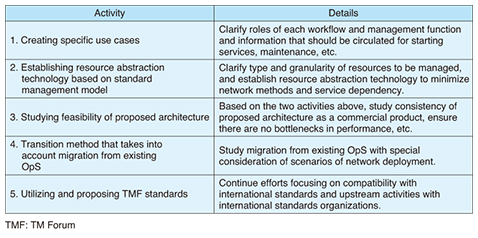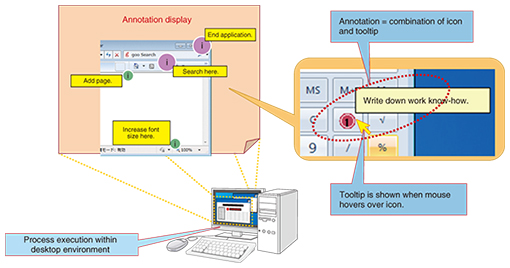 |
|||||||
|
|
|||||||
|
Feature Articles: NTT Tsukuba Forum 2015 Workshop Lectures Vol. 14, No. 4, pp. 35–40, Apr. 2016. https://doi.org/10.53829/ntr201604fa5 
Operations Technologies to Improve Work Efficiency and Create ValueAbstractThe Access Operation Project of NTT Access Network Service Systems Laboratories is focused on the research and development of operations systems in access networks. This article introduces the roles that operations play in the NetroSphere concept, the environment that we seek to realize through operations, and different navigation technologies implemented to realize efficient execution of tasks without affecting existing systems. Keywords: NetroSphere, integrated control, navigation 1. IntroductionNTT established the NetroSphere concept [1] as a new research and development (R&D) concept to transform the future of carrier networks. In this concept, functions that make up the network are treated as much as possible as small components. Service providers offer needed services by combining these components with complete freedom and control. In such a concept, the required operations functions change greatly. Operations in the NetroSphere concept require the following capabilities. • The ability to seamlessly manage the virtual layer and the real layer • The ability to flexibly build services that meet needs by combining componentized network functions and service functions • The ability to provide frameworks that enable efficient and effective collaboration with service providers having diverse requirements The vision of the computing environment we are aiming for in order to realize these abilities is presented in Fig. 1. This vision centers on the provision of network/cloud/applications by multiple businesses to service providers in a one-stop manner, which we refer to as one-stop operations. Furthermore, an approach called Integrated Control, described below, is necessary to provide the underlying support for one-stop operations and to improve the efficiency of end-to-end (E2E) operation tasks.
In NTT laboratories, we are currently studying five directions of future operations that will help to achieve the environment we seek to realize through operations (Fig. 2). In this article, we introduce the Integrated Control technologies, which are elements of Service Orchestration, a major component of one-stop operations. We also introduce the Navigation technologies, which are elements of Simple & Smart Operation, a direction of study intended to reduce the workload of operators.
2. Integrated Control technologiesConventional networks use dedicated equipment for each service, and therefore, specialized operations systems (OpS) are being developed for each type of dedicated equipment. Because network operations are managed by specialized OpS, silo systems arise in which services, network functions, and operations are tightly bound. Such silo architectures make it difficult to achieve collaboration that spans services. Moreover, collaboration that spans domains even within the same service requires a large amount of manual intervention, and it is difficult to provide multiple services in a one-stop manner. Adding network functions and services also requires modifying multiple OpS. We have been conducting R&D on Integrated Control technologies as a means to resolve these issues. Here, integration has two meanings: • E2E management that seamlessly manages the operations of network functions implemented on access networks, transmission routes, and datacenter servers. • Seamless operations management of the physical layer, logical layer, and service layer. Integration does not mean making multiple operations systems into one system. It refers to providing services by organically joining the multiple systems that manage each domain. By establishing the Integrated Control technologies, we can expect to achieve benefits in the form of faster provision of services, improved network convenience, and reduced OPEX (operating expenses). The benefits of Integrated Control technologies include the ability to start services immediately. For example, at present when a service provider applies for multiple services, it faces various challenges. For example, there is a long lead time needed to start the services, and applications have to be prepared for each service. Also, the operational conditions of the equipment used for each management domain are confirmed by the OpS of each service, and tasks such as design and configuration need to be carried out. By contrast, in an environment in which Integrated Control technologies and one-stop operations are combined, APIs (application programming interfaces) related to the application of services by service providers are established, making it possible for service providers to apply for services with inter-system connections. The function that receives the application can carry out E2E unified management of resources and available space. It thus becomes easy to secure resources and to automatically perform batch configuration in an E2E manner. The lead time for starting services can then be greatly reduced. An example of the architecture used to achieve Integrated Control is shown in Fig. 3. The first point to note is the separation of service management and resource management. To build new services by flexibly combining services, our approach is to separate and loosely couple the management of services, which tie service catalogs and their management with users, and the management of resources, which are resources for providing services.
The second point to note is the separation of network resource management and server resource management. Network systems and server systems differ greatly in terms of their management targets, for example, lifecycle. Our approach therefore is to separate management systems into network resource management and server resource management, as well as E2E resource management, which connects these two management systems. As a use case example of automatic recovery, let us consider the role of each management function. When a piece of network equipment fails, network resource management functions are trapped inside the equipment. If new routing designs and configurations are implemented, there is no need to connect to other management functions to recover from the failure. In cases where a server installed in a datacenter fails, connections with other management functions are not necessary because services can be recovered if available resources are secured on other servers within the same datacenter and necessary network functions are started up. However, if available resources cannot be secured on other servers within the same datacenter, it is necessary to recover services using a datacenter in a different location. In this case, network routes between datacenters must be combined and modified. E2E resource management functions control network resources and server resources in an integrated manner and also reconfigure new routes and change datacenters. In this way, recovery is implemented by E2E. By realizing the Integrated Control technologies as explained above, the creation of new value can be accelerated with operations such as creating new services and promoting collaborations between service providers. The efforts planned on the Integrated Control technologies as we go forward are listed in Table 1.
3. Navigation technologiesWe introduce here the Navigation technologies that contribute to reducing the burden of operators’ tasks. Diverse work support systems are being introduced with the aim of improving work efficiency in a wide range of fields, not just communications services. Workflows that serve as the basis of work support systems are changing rapidly due to factors such as changes in laws, the introduction of new services, changes in marketing campaigns and organizational structure of the company, and differences in individuals’ skills. Changing work support systems to meet changes in such workflows usually requires a substantial expense and a lot of time, and thus is not a realistic solution. As a result, irregular tasks not covered by work support systems remain. Compared with tasks that are systematized, even when they occur with low frequency, such irregular tasks often involve issues such as complex operational procedures, a long work time, and the tendency for operational mistakes to occur. Know-how and hands-on help from experienced operators are being utilized to deal with these issues. We believe that radical measures are needed to effectively and efficiently carry out human-mediated work and are therefore carrying out R&D on Navigation technologies to resolve these problems. Navigation technologies are technologies that achieve the implementation of operations more efficiently by reducing the number of operations and simplifying work content without affecting existing operations systems. The elemental technologies we are developing are indicated in Fig. 4. The horizontal axis represents the level of complexity of the required work. The vertical axis represents in general the quantity of required operations. The work on commercializing the UMS (Unified Management Support System) and the Data Bridge has already been completed. We are currently conducting R&D on three elemental technologies: system-linked integration technology, operational log acquisition/utilization technology, and annotation technology [2]. We describe here the annotation technology.
An overview of annotation technology is shown in Fig. 5. Annotation here means technology that provides operational support by allowing electronic sticky notes to be attached and displaying information considered necessary by the terminal operator. The features of annotation technology are as follows.
• It can be applied to numerous work scenarios thanks to its overlay display technology, which uses a versatile framework that is not dependent on particular tasks. • Users themselves can create and edit display tools, and manage and share them as definition files. • The technology can be used without modifying the existing system or changing the terminal’s environment, enabling low-cost operation of the technology. Some examples of uses of the annotation technology are listed in Table 2. The following functions have already been implemented. • A function to overlay fixed information on the operations screen based on display rules • The ability to create display rules using a GUI (graphical user interface) rather than programming them • Linking functions for calling external office tools
As the first stage in improving the sophistication of the annotation technology, we are studying the development of a function that switches fixed information written in advance based on the attributes and environment of the user; it then presents the selected information to the user. As a specific use scenario, we are studying the development of a system that can provide effective work support by switching the user profile based on the skills of the operator—for example, depending on whether the operator is a beginner or a veteran—and also based on the work content. We are also studying the development of a system in which multiple users cooperate to create annotations from various perspectives. The system then efficiently edits the necessary subset from the aggregated information. Finally, we are studying the development of a system that automatically generates useful user-support information from user operation logs and displays such information appropriately based on the user’s work progress and operational state. As a specific use scenario, we are seeking to create a system that provides a recommendation function. When a user has difficulty in the middle of performing an operation, the system automatically generates optimal annotation information that suits the situation from information including the operations history to date, and presents the information as a recommendation to the user. References
■Author profileHideaki HaradaExecutive Manager, Access Network Operation Project, NTT Access Network Service Systems Laboratories. He received a B.S. and M.S. in information and computer sciences from Toyohashi University of Technology, Aichi, in 1989 and 1991. He joined NTT Transmission Systems Laboratories in 1991 and engaged in research on optical access network management systems. From 2001 to 2007, he was with NTT WEST R&D Center, where he worked on optical access and wireless access technologies. After returning to NTT in 2007, he engaged in R&D of network management systems. He is a member of the Institute of Electronics, Information and Communication Engineers. |
|||||||















